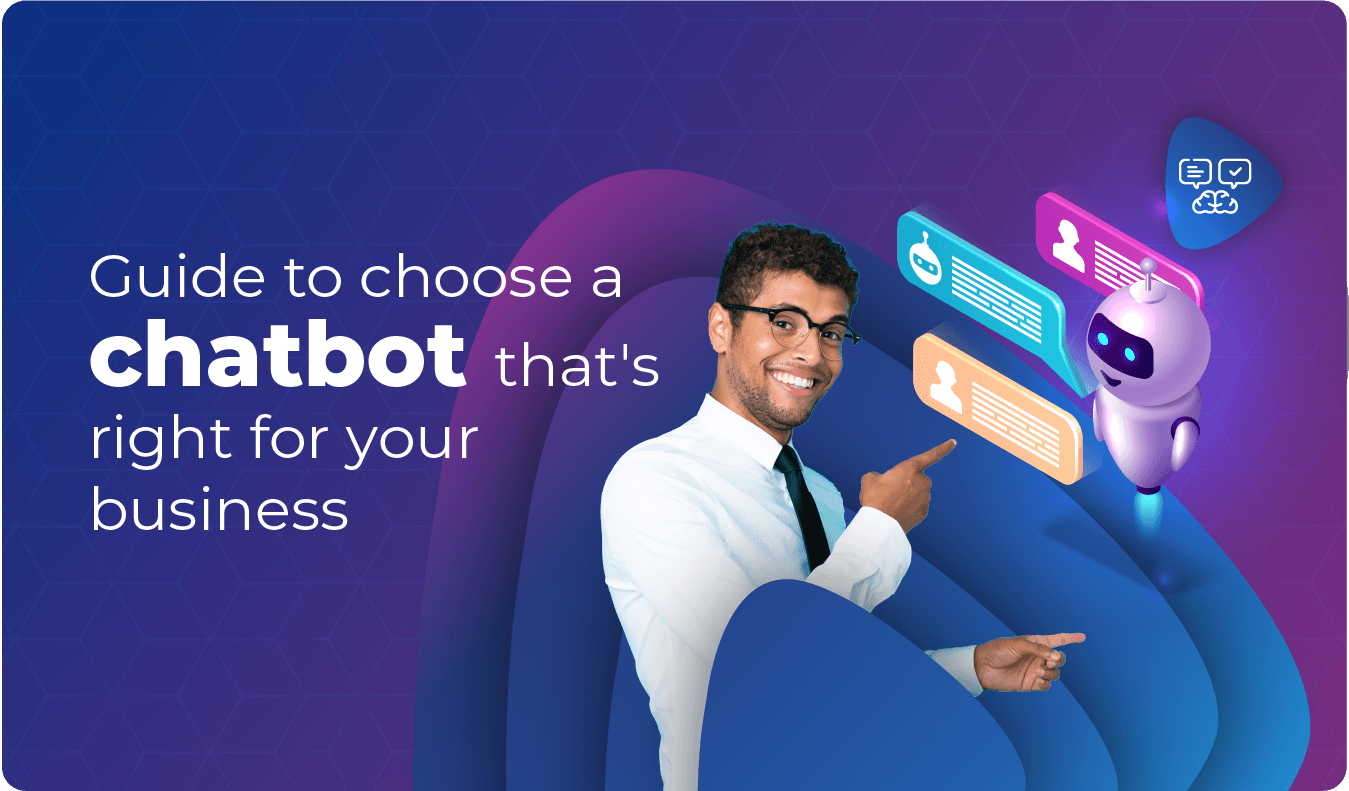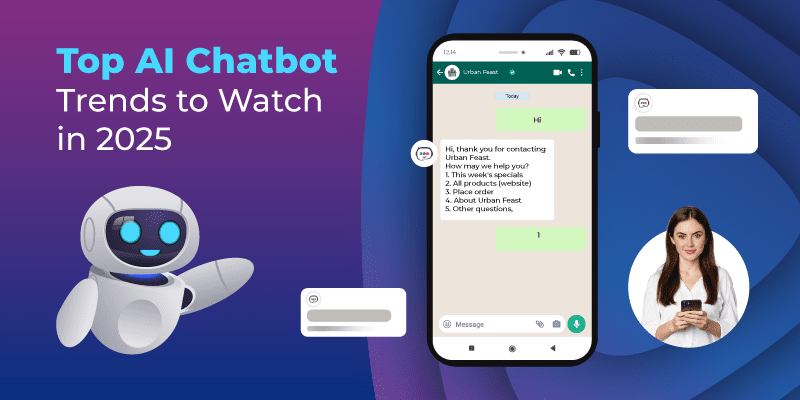According to Forbes , by 2025, AI will power 95% of customer interactions.
Artificial Intelligence has entirely changed the way businesses approach their customers or prospects. Chatbots have become the focal point of customer engagement.
They are automated computer programs offering customer communication and interaction for improved and personalised customer experience. The conversational AI market size is expected to increase from USD 10.7 billion to USD 29.8 billion by 2028.

Conversational AI-driven chatbots have become inseparable from customer service strategies in the past few years.
In this article, we explore the 4 different and effective ways to boost customer engagement using conversational AI chatbots.
Table of Contents:
The Role Of Conversational Chatbots In Boosting Customer Interaction
The global chatbot market size will grow from $7.01 billion in 2024 to $20.81 billion in 2029.
The traditional chatbots relied primarily on scripted responses against a given set of inputs with a one-size-fits-all. It lacks a specific response, which often leads a consumer to frustration.
Hence, AI-powered conversational chatbots are much more sophisticated and detailed. They naturally converse with customers with rapid auto-responses utilizing big customer data on which they are trained.
A well-designed and customized chatbot will stimulate human conversation through text and voice interactions.
Just like any live agent, AI chatbots can easily hold a natural conversation, improving customer interaction quality and increasing customer engagement.
To begin with, chatbots are capable of establishing natural automated conversations utilising conversation AI technology.
These customisable chatbots can identify customer preferences and buying patterns. They are also capable of predicting potential sales by analysing customer data.
Also Read: The Power Of Advanced NLP And Machine Learning in AI Chatbots
4 Key Ways Conversational Chatbot Boosting Engagement

Here are the key ways conversational chatbots boost customer engagement :
1. Automated Customer Service
Conversational AI chatbots have improved customer service dramatically by offering 24/7 availability, personalised user experience, scalability, automated instant responses and consistent quality.
It also helps businesses easily offer multilingual support, increase efficiency, reduce wait times, minimize errors and provide valuable insights to grow the business exponentially.
Since chatbots are capable of learning responses and efficiently processing large amounts of data, they are not just fast but also personalize the customer experience for maximum conversions.
2. Encouraging Self-Services
More than 67% of customers prefer self-service to talk to a customer service representative. This speaks volumes about the consumers being independent, self-reliant and technologically aware.
Businesses must accommodate this inclination of customers preferring to choose self-service using conversational chatbots.
63% of businesses are using some form of AI-powered customer self-service.
Conversational chatbots utilise the full scope of self-service technology to engage with customers, providing:
- Automated form of self-service without any need for human intervention.
- Providing details about products/services
- Helping customers choose the best product using customer data and interaction in real-time
- Gather information about customers, including:
- – Past product purchases
- – Rouch topic ( using NLP)
- – Customer data such as demographic, language, etc.
- – Product(s) the user is interested in
- Smart escalation approach after gathering data, saving tons of time and effort per ticket
Overall, using conversational AI helps businesses in:
- Saving a lot of time, effort, money and resources
- Providing 24/7 automated, instantaneous support
- Improving customer experience
- Boosting customer satisfaction
- Improving live support agents’ productivity
- Collecting valuable data and insights
- Increasing customer engagement
- Aiding in scalability
Also Read: Guide To Choosing A Chatbot That’s Right For Your Business
3. Upselling & Cross-selling
Integrating conversational chatbots in the sales and marketing process proves to be a game-changer for businesses that want to leverage effective upselling and cross-selling strategies.
Providing instant responses to queries around the clock where real-time interaction and immediacy optimise the possibility of successful upselling and cross-selling opportunities.
Conversational chatbots can also gather and analyse customer data and behaviour to offer personalised product recommendations, increasing teh chances of conversion dramatically.
Read More: An Overview Of Roubot’s Unique Applications
4. Cart Abandonment Recovery
Conversational chatbots are capable of helping businesses with their most frustrating online retail challenges – cart abandonment!
In fact, according to the Baymard Institute, almost 70% of shoppers abandon their carts.
Cart abandonment refers to shoppers starting the checkout process but failing to go through with the purchase.
Conversational chatbots are powerful tools to help in abandoned cart recovery, a strategy to convert abandoned carts into sales.
Since this requires marketing automation, chatbots are game-changers in bringing the customer down the sales funnel to complete their purchases.
Here are some top reasons for cart abandonment and how conversational chatbots can resolve it.
- High or unexpected cost: Conversational chatbots can offer free shipping or special discounts to encourage abandoned cart users to finish purchasing.
- Exploring or comparing products: Customers often browse, explore or research products and add them to the cart to compare. This doesn’t turn out to be a sale mostly due to lack of information on the product. Chatbots can offer detailed information on every potential query on the product.
- Lack of trust: Chatbots can develop trust and authenticity through sharing positive reviews, testimonials and offers like money-back guarantees, replacements and refunds.
- Technical Issues: A wide array of technical glitches, such as slow-loading websites, crashes, errors, low response times, and downtimes, can prevent customers from buying the product. Chatbots can retarget these customers to navigate their checkout process and even encourage them with additional special offers and discounts.
- Facing difficulty in the checkout process: conversational chatbots can be available 24/7 with instant automated responses to help them with all kinds of signup issues.
Conclusion
Conversational AI-powered chatbots allow businesses to take a much more personalised approach.
With rapid automated responses and the ability to answer a wide range of questions about the product or service, they ensure high customer engagement and satisfaction levels.
Businesses that aim to leverage conversational AI chatbots for customer service and automation must consider collaborating with a reputed BSP.
Route Mobile is a leading cloud communications platform offering chatbot integration and other business communication-related solutions. Contact our experts to get started.
FAQs
What Are The 4 Types Of Chatbots?
Rule-based, hybrid, contextual, and AI are the primary types of chatbots. Some other types include predictive, declarative, menu-based, voice-enabled, and keyword recognition-based, which are some additional types to consider.
How To Make A Chatbot More Conversational?
To make chatbots more conversational, first, decide on its purpose, then give it a persona, keep it consistent every time, craft potential scenarios for conversation, test the flow, and decide how to wrap it up.
What Is the Conversational Flow Of A Chatbot?
The conversational flow of a chatbot refers to a decision tree guiding users through their journey when they reach out to you or land on the website.







